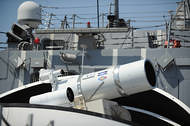
Laser Weapon System (LaWS) temporarily installed aboard the guided-missile destroyer USS Dewey (DDG 105) in San Diego, Calif., is a technology demonstrator built by the Naval Sea Systems Command from commercial fiber solid state lasers., a photo by Pan-African News Wire File Photos on Flickr.
April 8, 2013
Navy Deploying Laser Weapon Prototype Near Iran
By THOM SHANKER
New York Times
WASHINGTON — The Navy is going to sea for the first time with a laser attack weapon that has been shown in tests to disable patrol boats and blind or destroy surveillance drones.
A prototype shipboard laser will be deployed on a converted amphibious transport and docking ship in the Persian Gulf, where Iranian fast-attack boats have harassed American warships and where the government in Tehran is building remotely piloted aircraft carrying surveillance pods and, someday potentially, rockets.
The laser will not be operational until next year, but the announcement on Monday by Adm. Jonathan W. Greenert, the chief of naval operations, seemed meant as a warning to Iran not to step up activity in the gulf in the next few months if tensions increase because of sanctions and the impasse in negotiations over the Iranian nuclear program. The Navy released video and still images of the laser weapon burning through a drone during a test firing.
The laser is designed to carry out a graduated scale of missions, from burning through a fast-attack boat or a drone to producing a nonlethal burst to “dazzle” an adversary’s sensors and render them useless without causing any other physical damage.
The Pentagon has a long history of grossly inflating claims for its experimental weapons, but a nonpartisan study for Congress said the weapon offered the Navy historic opportunities.
“Equipping Navy surface ships with lasers could lead to changes in naval tactics, ship design and procurement plans for ship-based weapons, bringing about a technological shift for the Navy — a ‘game changer’ — comparable to the advent of shipboard missiles in the 1950s,” said the assessment, by the Congressional Research Service, a branch of the Library of Congress.
The study found that the new high-energy laser “could provide Navy surface ships with a more cost-effective means of countering certain surface, air and ballistic missile targets.”
Among the limitations, according to the research service, is that lasers are not effective in bad weather because the beam can be disturbed or scattered by water vapor, as well as by smoke, sand and dust. It is also a “line of sight” weapon, meaning that the target has to be visible, so it cannot handle threats over the horizon. And enemies can take countermeasures like coating vessels and drones with reflective surfaces.
Navy officials acknowledge that the first prototype weapon to be deployed is not powerful enough to take on jet fighters or missiles on their approach. That capability is a goal of researchers.
Among the advantages cited in the study for Congress was the low cost — less than $1 per sustained pulse — of using a high-energy laser against certain targets. By comparison, current short-range air-defense interceptor missiles cost up to $1.4 million each.
The laser weapon also has a limitless supply of ammunition — pulses of high energy — so long as the ship can generate electricity. The beam can reach its target at the speed of light and can track fast-moving targets.
Rear Adm. Matthew L. Klunder, the chief of naval research, said the high-energy laser system was developed as part of the Navy’s search for “new, innovative, disruptive technologies.” In essence, the Navy is trying to harness technological advances in battling adversaries that are thinking of inventive ways to counter American power.
Admiral Klunder said the weapon had destroyed targets in all 12 of its field tests.
The laser prototype cost just under $32 million, officials said. But if the weapon proves itself during its sea trials, and the order is given to buy the laser system for service across the fleet, the price per unit is expected to drop.
Rear Adm. Thomas J. Eccles, the deputy commander for naval systems engineering, said the first laser device would be deployed on the Ponce, which serves as a floating base for military operations and humanitarian assistance in the waters of the Middle East and southwestern Asia.
Iran has two navies: a traditional force of large older ships and a rival one run by the Islamic Revolutionary Guards Corps that consists of fast-attack speedboats with high-powered machine guns and crews that employ guerrilla tactics, including swarming perilously close to American warships.
A significant confrontation between the United States and the Revolutionary Guards occurred in 2008, when five of Iran’s armed speedboats made aggressive maneuvers as they approached three American warships in international waters in the Strait of Hormuz. Pentagon officials said the commander of a Navy destroyer was on the verge of issuing an order to fire when the speedboats pulled away; no shots were fired.
No comments:
Post a Comment